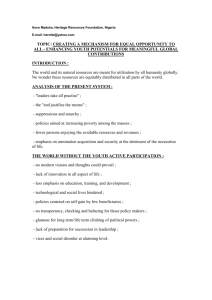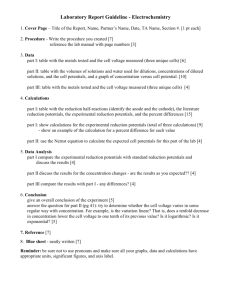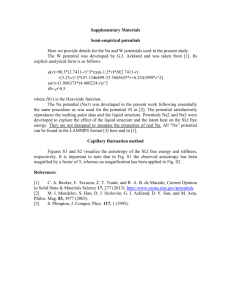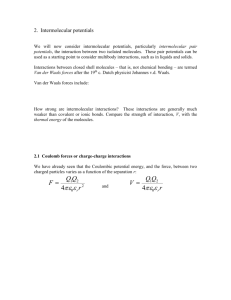Presentation (PowerPoint File)
advertisement
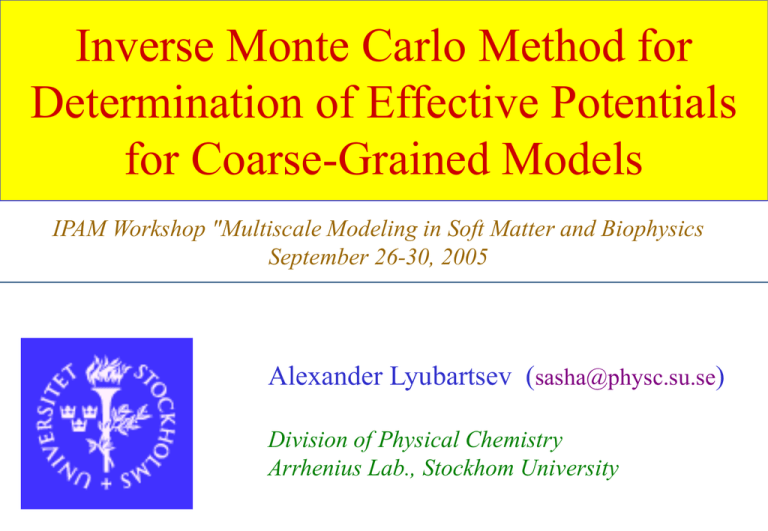
Inverse Monte Carlo Method for
Determination of Effective Potentials
for Coarse-Grained Models
IPAM Workshop "Multiscale Modeling in Soft Matter and Biophysics
September 26-30, 2005
Alexander Lyubartsev (sasha@physc.su.se)
Division of Physical Chemistry
Arrhenius Lab., Stockhom University
Outline
1. Introduction
why do we need multiscale coarse-grained modeling
2. Inverse Monte Carlo Method
how to build effective potentials for coarse-grained models
3 Effective solvent-mediated potentials
ion-ion and ion-DNA
4 Coarse-grained lipid model
large-scale simulations of lipid assemblies
Why do we need coarse-grained modeling?
Ion density profile ( M/l )
a) polyelectrolyte problem: ions around DNA
(+2) MC
(+2) PB
(+1) MC
(+1) PB
(-1) MC
(-1) PB
1
0.1
10
20
30
40
r (Å)
Atomistic MD: not really
possible to sample distances 3040 Å from DNA
Primitive model (MC) - how
good it is?
b) Lipid bilayer in water
Lipid (DMPC)
All-atom MD:
1 lipid - more than 100 atoms (DMPC -118, DPPC - 130)
''minimal'' piece of bilayer: 6x6x2 = 72 lipids
add at least 20 water molecules per lipid ⇒ about 13000 atoms
(the picture above contains about 50000 atoms)
A good object to waste CPU time....
Multiscale approach
All-atomic model
Full information
MD simulation
(but limited scale)
Coarse-graining –
simplified model
Effective potentials
for selected sites
Reconstruct potentials
(inverse Monte Carlo)
RDFs for selected
degrees of freedom
Increase
scale
Effective
potentials
Properties on a larger
Simulation of coarse
length/time scale
grained model
(MD,MC,BD,DPD...)
Inverse Monte Carlo
Model
Interaction
potential
direct
inverse
Properties
Radial distribution
functions
•Effective potentials for coarse-grained models from "lower
level" simulations
(atomistic coarse grained; CPMD atomistic)
•Reconstruct interaction potential from experimental RDF
•An interesting theoretical problem
The method
(A.Lyubartsev and A.Laaksonen, Phys.Rev.A.,52,3730 (1995))
Consider Hamiltonian with pair interaction:
V
H V (rij )
i, j
Make “grid approximation”:
H V S
Hamiltonian can be
rewritten as:
|
|
|
|
|
| |
=1,…,M
Where V=V(Rcut/M) - potential within -interval,
S - number of particle’s pairs with distance
between them within -interval
Note: S is an estimator of RDF:
1
V
g (r )
S
2
2
4r r N / 2
Rcut
Set of V , =1,…,M Space of Hamiltonians
direct
{<S>}
{V}
inverse
In the vicinity of an arbitrary point in the space
of Hamiltonians one can write:
S
S
V
V O(V 2 )
where
dqS (q) exp V S (q)
S
S S S S
V
V
dq exp V S (q)
= 1/kT
q r1 ,..., rN
Choose trial values V(0)
Direct MC
Calculate <S> (n) and differences
<S>(n) = <S >(n) - S*
Solve linear equations system
Obtain V(n)
New potential: V(n+1) =V(n) +V(n)
An analogueS
Newton method
S
S(V)
V
S*
V * V1 V0
V
Repeat until convergence
Algorithm:
Initial approximation:
mean force potential
V(0) =-kTln(g*(r))
Some comments
• Solution of the inverse problem is unique for pair potentials
(with exception of an additive constant)
gik(r) Vik(r)+const
• There exist a simpler scheme to correct the potential:
V(n+1)(r) = V(n)(r) + kT ln(g(n)(r)/gref(r))
(A.K.Soper, Chem.Phys.Lett, 202, 295 (1996))
Its convergence is however slower and may not work in
multicomponent case
• The precision of the inverse procedure can be defined by
analysing eigen values and eigen vectors of the matrix S
V
Effective solvent-mediated potentials.
Two levels of simulation of ionic, polymer or other solutions:
1) All-atom simulations (MD) with explicit water.
10000 atoms - box size ~ 40 Å
2) Continuum solvent, solutes - some effective potential, for example,
ions - hard spheres interacting by Coulombic potential with suitable e.
Ion radius - adjustable parameter (so called "primitive electrolyte
model")
The idea is to build effective solvent-mediated potential, which,
maintaining simplicity of (2), takes into account molecular structure of
the solvent
A. Effective solvent-mediated potentials
between Na+ and Cl- ions
Reference MD simulations:
H2O
Na+
Cl-
flexible SPC model
(K.Toukan, A.Rahman, Phys.Rev.B31, 2643 (1985)
s=2.35Å, e=0.544 kJ/M
s=4.4Å, e=0.42 kJ/M
(D.E.Smith, L.X.Dang, J.Chem.Phys., 100, 3757 (1994)
Double time step algorithm, with short time step 0.2fs and long time
step 2fs, was used NPT-ensemble, T=300K, P=1atm,
Ion-ion effective
potentials
Ion-ion RDFs
4,0
6
3,0
RDF
2,5
2,0
1,5
1,0
0,5
0,0
NaCl, L=39Å
NaCl, L=24Å
NaNa, L=39Å
NaNa, L=24Å
ClCl, L=39Å
ClCl, L=24Å
Prim. model
4
Eff. Potential / kT
NaCl, L=39Å
NaCl, L=24Å
NaNa, L=39Å
NaNa, L=24Å
ClCl, L=39Å
ClCl, L=24Å
3,5
2
0
-2
5
r (Å)
10
5
r (Å)
10
15
NaCl osmotic and activity coefficients
Solvent-mediated effective potentials were applied to calculate osmotic and
activity coefficients of Na+ and Cl- ions in the whole concentration range. MC
simulations are carried out for 200 ion pairs using effective potentials
Osmotic coefficient:
osm. coef
activity coef
1.3
1.2
1 F / c
P V
osm
kT c T NkT
Activity coefficient:
ex
exp
kT
1.1
1.0
0.9
0.8
0.7
0.6
1E-3
0.01
0.1
1
Concentration (M)
Lines are calculated values and points are experimental data
B. Ion-DNA effective solvent-mediated
potentials
Molecular dynamics:
• One turn of DNA (dATGCAGTCAG): 635 atoms,
CHARMM force field
(A.D.MacKerell, J.Wiorkiewicz-Kuchera, M.Karplus, JACS, 117, 11946
(1995))
• flexible
SPC water model + ions:
Run
1
2
3
4
5
No. of H2O
500
500
1050
1050
500
Counterions
20 Li+
20 Na+
30 Na+
30 K+
20 Cs+
Coions
-
-
10 Cl-
10 Cl-
-
Simulation time
(ns)
2.5
2
2.5
2.5
1.5
All-atom model:
Coarse-grained model
Na+
Ion - DNA effective potentials
Ion - P
6
+
Li
6
+
+
Na
4
+
K
+
Cs
0
-2
-4
+
Na
Eff. potential / kT
+
Li
+
Na *
2
+
Li
Na
+
4
Na *
+
K*
+
Cs
2
0
Eff. potential / kT
6
Eff. potential / kT
Ion - C4’(sugar)
Ion - C4 (base)
+
4
Na *
+
K*
+
Cs
2
0
-6
2
4
6
8
r (Å)
10
12
14
16
2
4
6
8
r (Å)
10 12 14 16
-2
2
4
6
8
r (Å)
10
12
14
16
MC simulation: a bigger DNA fragment (3 turns) in a box 100x100x102Å,
ions interacting by effective solvent-mediated potentials; no explicit water.
These are results for the density profile and integral charge
1.0
+
Li
1
0.8
+
NA *
Integral charge
Density profile (M/l)
+
Na
+
K*
+
Cs
PB
0.1
+
0.6
Li
+
Na
+
Na *
0.4
+
K*
+
Cs
PB
0.2
0.01
0
10
20
30
r (Å)
40
50
0.0
0
10
20
30
r (Å)
40
50
Relative binding affinities of ions
The order of relative binding affinities of alkali counterions to DNA,
defined by MC simulation with effective potentials, is:
Cs+ > Li+ > Na+ > K+
The binding order was defined also in a number of experimental works:
•P.D.Ross, R.L.Scruggs, Biopolymers, 2, 89 (1964) ; Electrophoresis:
Li+>Na+>K+
•U.P.Strauss, C.Helfgott, H.Pink, J.Phys.Chem.,71,2550 (1967); Donnan equilibrium:
Li+>Na+>K+
•S.Hallon et al, Biochemistry, 14, 1648 (1975); Circular dichroism
Cs+>Li+>K+>Na+
•P.Anderson, W.Bauer, Biochemistry, 17, 594 (1978), DNA supercoiling
Cs+>Li+>K+>Na+
•M.L.Bleam, C.F.Anderson, M.T.Record, Proc. Natl.Acad.Sci USA,77,3085 (1980), NMR:
•I.A.Kuznetsov et al, Reactive Polymers, 3, 37 (1984), Ion exchange
Cs+>Li+>K+>Na+
Li+>K+Na+
Qualitative agreement with results of experiments of very different nature.
Coarse-grained lipid model
All-atom model
118 atoms
Coarse-grained model
10 sites
We need interaction potential for the coarse-grained model !
Use IMC and RDFs from atomistic MD.
All-atomic molecular dynamics
All-atomic MD simulation was carried out:
16 lipid molecules (DMPC) dissolved in 1600 waters (6688 atoms)
Box size: 40x40x40 Å
●
Initial state - randomly dissolved
RDFs calculated during 12 ns after 2 ns equilibration
●
●
Force field: CHARMM 27, water - flexible SPC
●
T=313 K
MD snapshot
16 DMPC lipids
1600 H2O
R D F calculations
N
P
4 different groups -> 10 pairs
10 RDFs and eff. intermolecular potentials
+ 4 bond potentials
CO
C
7
6
solid - 16 lipids
dashed - 64 lipids
NP
6
5
4
4
PP
3
RDF
RDF
5
NN
2
1
0
3
CC
2
PC
1
5
10
r(A)
15
20
0
NC
5
10
r(A)
15
20
Inverse MC simulations:
Purpose: find effective potentials which, for the coarse grained
model, reproduce the same RDFs as the all-atomic model
Intramolecular potentials:
Bonded: from distance distribution between the atoms.
Non-bonded - the same as intermolecular
Total: 14 effective potentials
Inverse MC - the box of the same size; the same number of lipids as in
the corresponding MD; no solvent: charges +1 and -1 on "N" and "P" +
dielectric constant e=70 (best fit to NN, NP and PP -potentials)
Effective potentials:
20
20
N - CO
N - CH
P - CO
P - CH
15
Veff (kJ/M)
Veff (kJ/M)
NN
10
PP
0
0
5
0
NP
-10
10
5
10
15
-5
20
r(A)
5
10
15
r(A)
20
15
N-P
P - CO
CO - CH
CH - CH
20
Veff (kJ/M)
Veff (kJ/M)
30
CO - CO
CO - CH
CH - CH
0
-10
r (A)
Bond potentials
20
10
10
5
20
10
0
3
4
5
r(A)
6
7
8
Coarse-grained simulations
●
Monte Carlo
●
Molecular Dynamics
Forces - from the potentials difference in the neigbouring grid points
Solvent is not present explicitly - MD may be considered only as another
way to generate canonical ensemble
Time step 10-14 s + thermostat
●
●
●
Nose-Hoover
Local (Lowe-Andersen)
Langevine
3 cases :
a periodic bilayer
a finite piece of bilayer
random initial state
Equivalent all-atom simulations would correspond ~ 106-108 atoms
Infinite bilayer
Z
Periodic box
Density distribution
Coarse-grained MC (392 lipids)
All-atom MD (98 lipids)
A sheet of bilayer
The same initial state, but in a large simulation box:
End of simulation: 109 - 1010 MC steps:
View from the side
View from the top
(discoid shape)
Vesicle formation
Start from a square plain piece of membrane, 325x325 Å, 3592 lipids:
cut plane
Membrane self-assembly
MD simulation of 392 CG lipids with Lowe-Andersen thermostat
http://www.fos.su.se/physical/sasha/lipids
Conclusions
1. The multiscale approach based on the inversion of radial distribution
functions provides a straightforward way to build effective potentials
for coarse-grained models
2. Examples of ionic solutions, ion-DNA interactions, lipid membranes
show that effective potentials, derived exclusively from the atomistic
model, provide realistic description for the coarse-grained model
3. Coarse-grained effective potentials may be plugged in into MC, MD,
Brownian dynamics, DPD and used for simulation on larger length- and
time scale
Acknowledgements
Aatto Laaksonen
Martin Dahlberg
Carl-Johan Högberg
